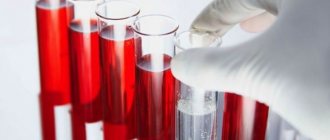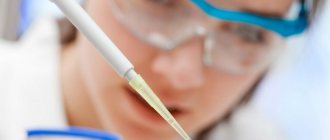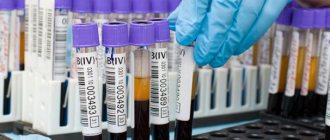Decoding the results of the analysis for total protein
The normal level of total protein in the blood ranges from 60 to 83 g/l. Levels may vary slightly depending on the reagents and equipment in the laboratory, as well as other factors such as age, gender and testing method.
If this indicator is not normal, in order to make a diagnosis, it is necessary to perform additional tests to determine which protein concentration is decreased or increased.
If total protein in the blood is elevated, this may indicate the following factors:
inflammation or infection (eg, hepatitis B or C, HIV)
Bone marrow disease (eg, multiple myeloma or Waldenström's disease)
This indicator is also elevated during pregnancy.
Low levels of whey proteins may indicate:
· bleeding,
liver pathology
kidney pathology (for example, nephrotic syndrome or glomerulonephritis)
· malnutrition
malabsorption (eg, celiac disease or inflammatory bowel disease)
· extensive burns
agammaglobulinemia
What does total blood protein mean? Lecture for doctors
The clinical biochemistry term “total blood protein” is the sum of all proteins present in the blood at the time of analysis. Normally it should be 100 g/l. Although most reference books offer a standard standard of 65-85 g/l. But this “standard” obviously contains a misunderstanding of the obvious: the amount of all proteins present in the blood at the time of analysis is a rigid genetic constant. Normally, it cannot have such a clear individual variation. Why?
Let's give a purely biological answer to this question. About 100,000 proteins are synthesized in the body. Total protein, like the tip of this iceberg, indicates genetic and physiological well-being.
About 100 proteins can be detected in blood. The entire genome (approximately 8,000 genes) is a piece of DNA that can be mentally “stretched” to the full height of a person and even more. Its length is 2 m. The genes are packed into 46 chromosomes and with this DNA they provide information about all the 100,000 proteins that are actually synthesized.
Different cells have different numbers of genes. The most primitive cell - the red blood cell - does not have a nucleus, which means it does not have genes. But its predecessor, the reticulocyte, has eight genes. The largest number of functioning genes is in nerve cells: 1560 genes in one neuron. (In a liver cell - hepatocyte - 300 genes, in a kidney cell - 800 genes.) The more genes, the more amino acids and proteins are required. Therefore, the power of the nervous system to suck out amino acids is not comparable to any other living functional apparatus. It can be compared to the most powerful vacuum cleaner! In this regard, potentially, physiologically, there is always a shortage of amino acids in the whole organism, and this deficiency is especially felt by the brain.
The movement of amino acids to the brain is similar to the movement of electric trains during rush hour. During ontogenesis, the brain develops during life. And the more intense its development, the greater its need for amino acids. After all, gray matter and synapses are nothing more than amino acids and proteins. In the body of an adult, the level of protein under physiological conditions cannot undergo sharp fluctuations. There is always at least a slight deficiency in protein.
The formation of one peptide bond (to connect proteins from amino acids) requires about 15 ATP molecules - this is a very energy-intensive process. The disappearance of 1 g of protein from the blood means the loss of 30 g of protein in the tissues. If 2 g of protein leaves the blood, then twice as much will disappear from the tissues - 60 g of protein, 3 g will entail a loss of 90 g, 4 g - 120 g, etc. Therefore, we emphasize once again that total blood protein normally cannot have a significant spread of values if a person:
a) eats well,
b) not sick,
c) matured, is an adult.
In this case, the value of total blood protein is strictly genetically determined.
It follows that if two patients, all other things being equal, have different levels of total protein, then this should most often be considered as a sign of well-being in one case and a sign of severe ill-being in the other. It is better to have a high total protein value than a low one. For example, the number 85 is better than 65 because 65 indicates a deficiency:
- immune system;
- complement system;
— bactericidal protein system;
- fat transport systems.
Book “Rules for Reading Biochemical Analysis”
The manual is intended for doctors of any specialty. The reader is invited to begin the study of medical biochemistry with the selection and medical understanding of the information from fundamental biochemistry that is necessary for a doctor for practical use in a specific situation with a specific patient. At the same time, this information should provide guidance on a deep (down to the molecular level) understanding of pathology, taking into account the basic biochemical processes, which are better known in theory as pathogenetic mechanisms and are rarely mentioned (although they certainly should be mentioned) in a doctor’s practice.
Seventeen rules for reading biochemical analysis are presented in the form of text, color illustrated diagrams, brief formulas and comments, which makes the medical course understandable for a wide range of readers: students of medical universities, academies, faculties, doctors, researchers, and applicants. The book is adapted for an inquisitive person who is interested in his own body and wants to have modern scientific ideas about himself.
The manual was prepared by the chief researcher of the Research Institute of General Pathology and Pathophysiology of the Russian Academy of Medical Sciences, leading researcher of the Central Research Institute of Epidemiology of Rospotrebnadzor of the Russian Federation, Doctor of Medical Sciences. Igor Mikhailovich Rosly.
Buy the book “Rules for reading biochemical analysis”
Contents of the book “Rules for reading biochemical analysis”
Rule 1. Introduction to medical biochemistry
Rule 2. Blood enzymes for biochemical analysis
Rule 3. ACT and transamination
Rule 4. ALT Glucose-alanine shunt
Rule 5. Biological meaning of the work of two transaminases: ACT and ALT
Rule 6. GGT is an enzyme for membrane transport of amino acids
Rule 7. Total blood protein indicator
Rule 8. Molecular processes of realization of the genotype in the phenotype and their violations
Rule 9. The structure of proteins as an illustration of their structural and functional role in the formation of living systems
Rule 10. Albumin, urea and creatine - indicators of catabolism
Rule 11. The role of amino acids in ensuring cerebral processes during normal brain activity
Rule 12. Basic blood enzymes
Rule 13. What is important for a doctor to know about cholesterol
Rule 14. Alkaline phosphatase
Rule 15. Lactate dehydrogenase
Rule 16. Creatine phosphokinase
Rule 17. Energy exchange
Rule 18. Algorithm for biochemical analysis performed by a doctor
Rule 19. Integration of metabolic and enzymological indicators (“enzyme-metabolic fan”)
Rule 20. Homeokinesis
Rules for reading biochemical analysis - Rosly I. M.
Reasons for the increase
When C reactive protein is elevated, there may be different reasons. Today they are divided into three main groups:
- Oncology.
- Inflammatory processes.
- Vascular pathologies.
The risks of developing certain diseases are assessed by the concentration of the substance in the blood:
- Less than 19 mg/l. This deviation is considered insignificant. Exceeding the norm can be triggered by any negative factor affecting the body. As a rule, in this case, analysis is required at a certain frequency. If constantly elevated CRP is detected, diagnostics are required to exclude autoimmune and oncological pathologies.
- 20-50 mg/l. Indicators always rise to this level with various viral infections.
- More than 100 mg/l. A bacterial infection can provoke a strong immune reaction in the body, against which serious diseases develop: pneumonia, salmonellosis, pyelonephritis, etc.
Causes of protein deficiency
- Impaired liver synthetic function
- the central metabolic factory. It is here that blood plasma proteins are formed: albumins and most globulins, which largely mediate the maintenance of homeostasis in the body.
This is accomplished by forming oncotic pressure: protein molecules, due to their chemical nature, attract water, thus exercising control over water-salt metabolism. An important consequence can be drawn from this: when the concentration of proteins in the blood serum is low or when they increase in the intercellular fluid and tissues, which is especially characteristic of inflammatory processes accompanied by increased vascular permeability, edema develops - water goes beyond the arteries and veins.
In diseases manifested by damage to hepatocytes (toxic or infectious agents), edema also occurs - and mainly on the lower half of the body and limbs. We wrote about this in more detail in this article:
- Nutritional factors
- fasting, generally leading to protein-energy deficiency, or an unbalanced and uncompensated plant diet with nutraceuticals, accompanied by a lack of essential amino acids in the diet - that substrate for the construction of cells and tissues that the body cannot reproduce on its own, from available elements and with the help of those present enzymes.
Below we have provided a small table with essential amino acids and the foods in which they are concentrated. We hope that this will help you competently organize and choose the type of nutrition that suits you.
| Valin | Isoleucine | Leucine | Lysine |
| eggs | soybeans | peas | chum salmon |
| milk products | peanut | perch | lentils |
| beef | egg yolk | turkey | chicken and turkey |
| lentils | pink salmon | milk | mutton |
| Methionine | Threonine | Tryptophan | Phenylalanine |
| eggs | sunflower seeds | turkey | beans |
| meat | pollock | squid | almond |
| milk and dairy products | zander | milk | cashew |
| mackerel | sesame | pistachios | cod |
- One of the most common pathologies that leads to difficulty absorbing protein from food is reduced acidity of gastric juice.
Hydrochloric acid produced by the parietal cells of the mucosa activates proteolytic enzymes and, in addition, promotes the swelling of protein molecules, facilitating enzymatic processing of food. It is also a powerful nonspecific protection factor that has a strong bactericidal effect - in particular, against protozoa, parasitic worms, bacteria and viruses.
The widespread popularity of self-administration and frequent prescription of proton pump inhibitors (“Omez”) has become a cause of serious concern among scientists about the likely consequences of their long-term use not only on the organs of the gastrointestinal tract, but on the body as such.
In addition to the effects of medications, disruptions in the folate cycle
(or rather, in the three main genes that regulate it: MTHFR, MTR, MTRR), since it is this that ensures the formation of the main mediator of the parasympathetic system - acetylcholine, which also stimulates the parietal cells of the stomach. When a mutation is detected, additional support for the body is necessary, aimed at reducing the concentration of homocysteine that accumulates in such conditions - an amino acid known for its damaging effect on the endothelium (the inner lining of the vessel) and plays an important role in the pathogenesis of atherosclerotic damage.
We recommend
“Vitamin D: top 30 foods with its high content” Read more
On the other hand, along with insufficient formation of acetylcholine, there is an increase in the inflammatory mediator - histamine. This occurs due to a disruption in the processes of its neutralization, normally carried out by methylation reactions. Considering that histamine is also an activator of gastric juice secretion, we can draw a logical conclusion: the effect of the folate cycle on the digestive system is somewhat ambiguous. It is logical to assume that under conditions of excessive intake of this biogenic amine, not only erosive lesions of the gastric mucosa develop, but also, due to increased permeability of the intestinal wall, structural elements of bacteria enter the systemic bloodstream - an inflammatory process is observed, and not limited to the gastrointestinal tract.
Another possible cause of hypochlorhydria is atrophic gastritis
- an autoimmune disease, accompanied by a decrease in the number of functioning cells due to their death during the “attacks” of antibodies from an immune system gone crazy, which ceases to clearly distinguish between what is “ours” and what is “foreign”.
- Damage to the gastric mucosa
: ulcers, gastritis, erosion. Despite the widespread belief in people’s minds that inflammation of the epithelial lining is purely caused by H. pylori, this cannot be compared with one hundred percent truth.
Firstly, infection occurs in early childhood, so the very concept of infection in adolescence or adulthood is more likely an ephemeral rarity than a truth as such.
Secondly, everything depends on the strain of the bacterium: not all of them are aggressive (or at least so strongly pathogenic that clinical manifestation and inflammation of the gastric mucosa itself appear) - and this entails mandatory diagnosis (at least before prescribing 2 weeks of antibiotic therapy). Considering the widespread distribution of the latter, which has already led to total resistance of the microflora (inhabiting both the distal parts of the small and large intestines of humans) to chemicals, as well as the bacterial past of mitochondria, our small power plants, selflessly producing energy, the decision to eradicate Helicobacter It should be well thought out by the doctor or nutritionist that resorting to more gentle therapy with nutraceuticals.
Helicobacter actually adapts (unlike most microorganisms) to the unfavorable conditions of the gastric environment: having a specific enzyme that breaks down urea, it alkalizes its habitat by releasing ammonia. However, pathology develops only when it disseminates - spreads from the pyloric region bordering the duodenum along the entire perimeter of the stomach.
Stress often leads to damage to the gastric mucosa
: it is accompanied by activation of the sympathetic nervous system with the subsequent release of adrenal medulla hormones into the blood, which, in turn, affecting the secretory apparatus of the kidneys, stimulate their release of a vasoconstrictor. It is the narrowing of the lumen of blood vessels, including those that supply blood to the stomach, that leads to subsequent ulceration of the mucous membrane.
- Impaired breakdown and absorption of proteins in the intestine.
The first is characteristic of exocrine pancreatic insufficiency, in which its secretory cells cease to form and release a sufficient amount of enzymes into the blood (and not only proteolytic ones). The second accompanies malabsorption syndrome and celiac disease - another autoimmune disease that, unfortunately, has ceased to be such a rarity today.
- Violation of bile formation and bile outflow,
which leads to the impossibility of not only the emulsification of fats, but also the activation of pancreatic enzymes. Helminthic infestation, blockage of the biliary tract by stones, decreased fluidity of this secretion due to the predominance of cholesterol over other components (bile acids and phospholipids) - a large number of possible causes necessitate careful laboratory and instrumental diagnostics, which build the missing puzzles in the clinical picture of the disease.
- Kidney diseases:
Normally, protein molecules are not filtered into primary urine due to their bulky size. However, if the renal filter is damaged (the formation of “holes” in it), massive proteinuria is observed, as evidenced by the detection of proteins in a general urine test.
General information
Those same peptide compounds that contain protein play a transport function in the circulatory system. That is, with their help, micronutrients enter the cells, and waste products are removed from them.
Protein is also an integral part of the formed elements, participating in the synthesis process:
- hemoglobin;
- red blood cells;
- leukocytes;
- platelets.
With the help of proteins, energy is also released from the burning of fats and carbohydrates, and accordingly, the nominal body temperature is maintained.
The main types of proteins in human blood plasma:
- Albumin is the main plasma protein and plays a key role in maintaining blood pressure and the osmotic movement of blood through the blood vessels. It is also a binder for complex lipid chains and many drugs.
- Globulins primarily take on the transport function. It is with their help that vitamins, minerals, and protein combinations (from which muscle tissue is subsequently formed) are distributed throughout the body. Globulins also take part in the functioning of the immune system, transporting leukocytes to sites of infection.
- Fibrinogen is a water-soluble protein that ranks third in terms of quantity in the blood. Upon contact with thrombin, it precipitates, forming so-called “fibron threads” - they form the basis of the fibrin polymer, which literally plugs damaged blood vessels in combination with platelets.
Above are only the main variations of proteins included in the blood. But in total there are over 100 varieties, each of which takes on a number of biochemical functions of the body.








